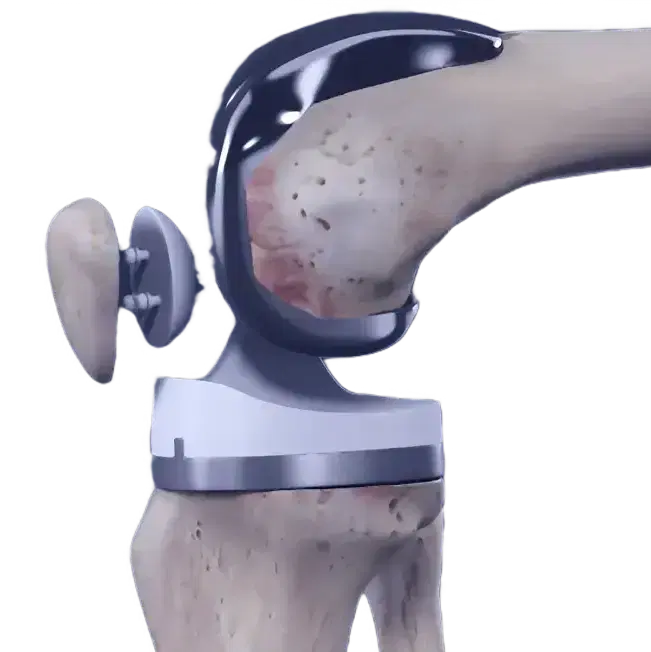
Knee Arthritis
What is arthritis?
Arthritis is a condition that causes the degradation of the normally smooth cartilage that lines the knee joint. When the condition is severe it can lead to destruction of the underlying bone. This can manifest as bowing/deformity of the knee.
This can lead to knee pain.


Other symptoms may include swelling, stiffness, grating, and tenderness.
What causes Osteoarthritis?
There are many different causes for arthritis. Most commonly the cause is unknown
Associated factors include:
Age
Family history
Body weight
Arthritis can be the result of other conditions such as
Inflammatory conditions such as rheumatoid or crystalline arthritis (such as gout), trauma to a joint, or any factor which changes the mechanical or metabolic environment of a joint

Are there different
stages of arthritis?
Arthritis is a disease with a spectrum of severity. At one end there is mild arthritis where the cartilage surface is rough or has cracks in it. At the other end of the spectrum there is severe arthritis where there is absolutely no cartilage left (“bone on bone”)
No arthritis

Mild arthritis

Severe arthritis

What are the
symptoms of arthritis?
The most common symptom is pain. Other symptoms may include

Swelling

Stiffness

Bowing

Heat

Walking
How is arthritis diagnosed?

Arthritis can usually be diagnosed on standard x-ray films
Specific images performed whilst the patient is weight bearing are the most accurate for identifying the loss of space between the bones, which indicates cartilage loss. Sometimes special x-ray views are required to demonstrate arthritis
Joint space on far left vs. no joint space on far right
In early arthritis, x-rays may look normal, needing a MRI scan to visualize cartilage damage
What are the non-surgical
treatment options?

There are many non-surgical options. They essentially aim to decrease pain by modifying activity and taking simple analgesia whilst aiming to maintain strength and flexibility in the joint.
Weight loss and physical activity
Encourage pain-free activities to maintain an ideal body weight, as weight loss significantly reduces arthritis pain by reducing joint load.
Steroid injections
Steroid injections help mild arthritis, but their effect duration is unpredictable (hours to months) Up to three injections/year may be needed.

Pain medications
Simple pain medications such as paracetamol, or non-steroidal anti-inflammatory drugs may help to control pain.
Viscosupplementation
Viscosupplementation agents like Synvisc, similar to steroids, may require repeated, costly injections due to unpredictability.

Knee sleeves/Unloading braces
Knee sleeves provide compression, control swelling, and offer joint support. Unloading braces shift weight to the unaffected side, reducing pain in select cases.
If pain persists despite medication and significantly limits work, leisure, and family activities, surgical intervention may be necessary.

What are the surgical
treatment options?
Surgical options should be considered when all non-surgical options have been exhausted. Options include:
Unicompartmental Knee Replacement (UKR)
In some cases, arthritis affects only one part of the knee, allowing for a unicompartmental knee replacement. This provides a more natural knee feeling and greater range of motion compared to total knee replacement. Regardless of the type of replacement, avoid pounding activities to prolong the prosthesis's lifespan.


Total Knee Replacement (TKR)
This is the gold standard surgery when the arthritis affects the majority of the knee in a patient that is suitable. It involves removal of the diseased cartilage throughout the entire knee, and replacement with a combination of a metal and plastic prosthesis. We expect the prosthesis to last 15-20 years.
Knee Osteotomy
In isolated knee arthritis cases, unsuitable for replacement, an osteotomy may be performed. By realigning the femur or tibia, load is shifted from the diseased to healthier knee parts, aiming to enhance pain relief and function. This typically involves cutting the thigh or leg bone to realign the leg entirely.


When should I have surgery?
1
You have exhausted all forms of non surgical treatment
2
You have realistic expectations for the outcome of the surgery
3
You're ready to embrace surgical risks and rehabilitation for a better quality of life and improved function.
4
You continue to experience persistent pain that significantly interferes with your function and overall quality of life.

What is the natural
history of arthritis?
For most patients the natural history is a slow progressive decline over many years.
This is typically punctuated by acute periods of deterioration, which can last days or weeks and typically settle with rest, activity modification and short courses (days to weeks not months) of simple analgesic medication.

In some patients there is a catastrophic decline with acute pain and deterioration in function, which fails to resolve after weeks of non-surgical treatment.

Do you need a
Knee replacement?
Dr Seeto in affiliation with Medibank Private and East Sydney Private hospital, offers a program for eligible Medibank Private Members, to eliminate medical out of pocket costs for your Knee Replacement.
The program includes a pre-surgery preparation program, spending the minimal time necessary in hospital, as well as home rehabilitation if necessary.
Book a consultation
today
9:00 am - 4:30 pm


